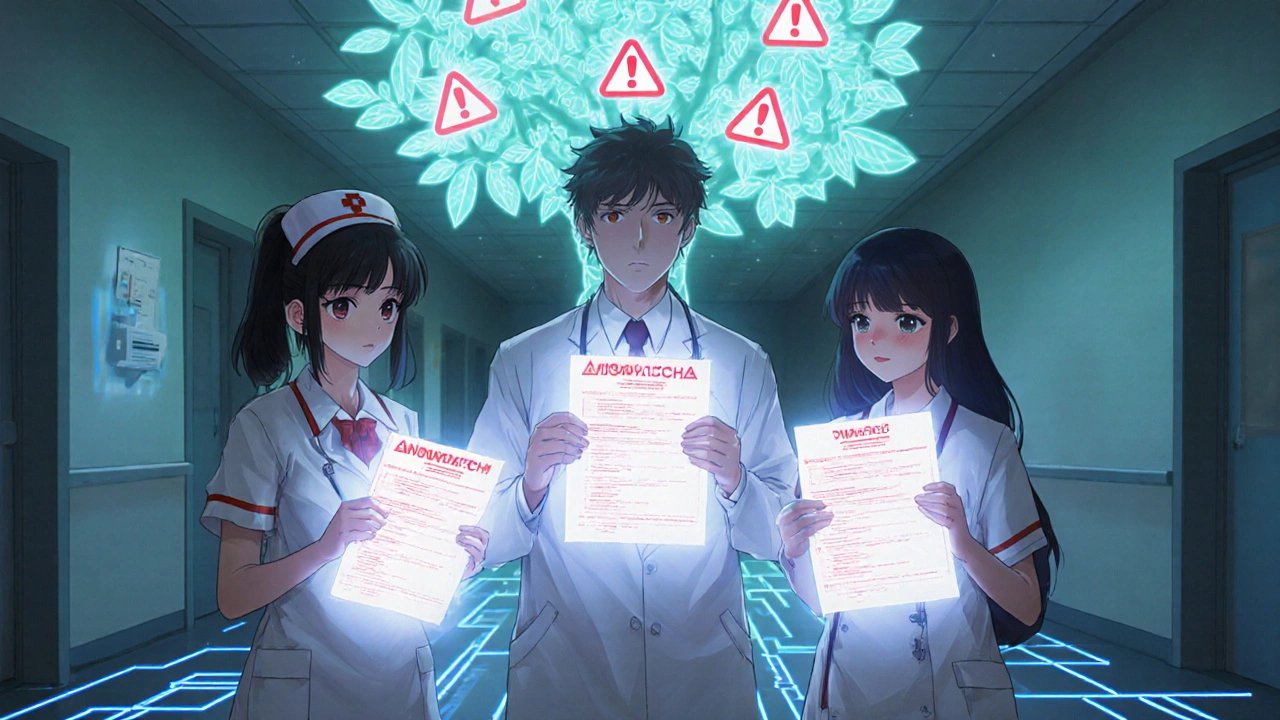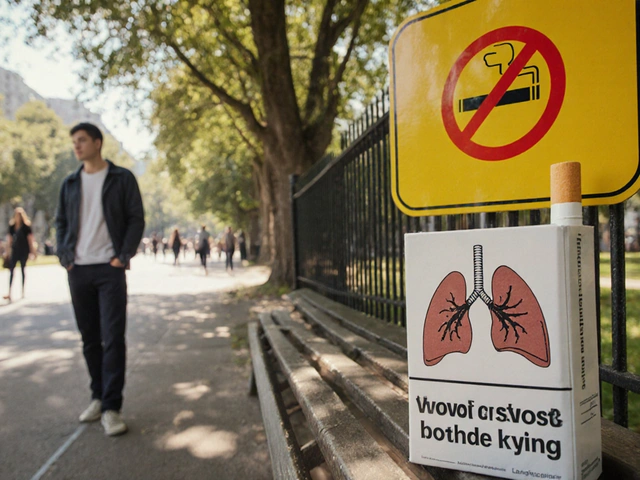Serious Adverse Event Checker
Is This a Serious Adverse Event?
The FDA defines a serious adverse event as one that results in:
Select any criteria that apply to your situation to determine if your reaction is serious enough to report to FDA MedWatch.
Every year, millions of people in the U.S. take prescription drugs, over-the-counter medicines, medical devices, or even cosmetics - and most of them are safe. But sometimes, something goes wrong. A medication causes a severe rash. A glucose monitor gives wrong readings. A CBD oil leads to dizziness and nausea. When that happens, your report matters. The FDA MedWatch system is how you tell the U.S. Food and Drug Administration about it - and it’s one of the most powerful tools we have to make medical products safer for everyone.
What Is MedWatch, Really?
MedWatch isn’t just a form you fill out. It’s the FDA’s official system for tracking problems with medical products after they’ve hit the market. Think of it like a national early warning system. While clinical trials test drugs on thousands of people before approval, real-world use involves millions - and unexpected reactions can show up only then. MedWatch collects those reports from doctors, nurses, patients, and manufacturers to catch dangers early. It covers a wide range of products: prescription and OTC drugs, blood products, gene therapies, diabetes test kits, insulin pumps, CBD oils, even hair dye and moisturizers if they cause serious harm. It doesn’t cover vaccines (those go to VAERS) or animal drugs (those go to CVM). But for nearly everything else you use to treat or monitor your health, MedWatch is the only official way to report issues to the FDA.Who Should Report and When?
You don’t need to be a doctor to report. Anyone can - patients, family members, caregivers, pharmacists, nurses, or even manufacturers. But the type of report you file depends on who you are.- Healthcare professionals (doctors, nurses, pharmacists): Use Form FDA 3500. You’re expected to report serious side effects, device failures, or product quality issues you see in practice. If a patient dies after taking a new blood pressure drug, or a heart monitor malfunctions during surgery - you report it.
- Consumers and patients: Use Form FDA 3500B. This is the simplified version. If you or someone you care for had a bad reaction - like vomiting after taking a new painkiller, or a rash from a new skin cream - you can file this yourself.
- Manufacturers and hospitals: Must report by law. If a company finds out one of its devices caused a death or serious injury, they have 30 days to report it. For deaths, they have just 10 working days.
How to File a Report - Step by Step
Filing a report is free and takes 10 to 20 minutes. Here’s how to do it right.- Decide which form to use. If you’re a patient or family member, go for Form FDA 3500B. If you’re a provider, use Form FDA 3500. Both are available online at fda.gov/medwatch.
- Gather basic info. You’ll need: the name of the product (brand and generic), the date you started using it, when the reaction happened, what symptoms occurred, and whether the person was hospitalized or had a life-threatening event. If you don’t know the exact name, describe it - “the blue pill for diabetes” or “the wristband that checks oxygen levels.”
- Fill out the form. The online form has big buttons, clear fields, and a simple layout. But watch out for jargon. Terms like “event abated” or “dose frequency” can confuse non-medical users. If you’re unsure what something means, skip it - or call the FDA at 1-800-FDA-1088 for help.
- Submit it. You can file online, by mail, or by fax. Online is fastest and most reliable. After submission, you’ll get an email confirmation. Don’t expect a follow-up call - but your report is logged and reviewed.
What Counts as a Serious Reaction?
Not every side effect needs reporting. The FDA defines a serious adverse event as one that results in:- Death
- Life-threatening condition
- Hospitalization (or prolonging an existing hospital stay)
- Permanent disability
- Birth defect
- Requires medical or surgical intervention to prevent one of the above

Why Consumer Reports Matter
Doctors report hundreds of cases. But patients report the details that professionals miss. A nurse might note “patient developed rash.” A patient might say, “I started the new birth control on Monday, and on Wednesday my face broke out in red bumps, my throat swelled, and I couldn’t breathe. I took Benadryl and went to urgent care.” That kind of detail - the timeline, the symptoms, what you did after - helps the FDA connect the dots. A 2019 FDA study found that 62% of consumers needed help understanding at least three terms on the form. That’s why the FDA now recommends: Bring the form to your doctor. They can help you fill it out with accurate medical terms, and even attach your records. But remember - your doctor is not required to report for you. You have the right to report on your own.What Happens After You Report?
Your report doesn’t vanish into a black hole. It goes into a database with over 1.2 million reports each year. FDA scientists look for patterns. If 10 people report the same rare reaction to a new diabetes drug, that’s a signal. If 50 people report the same device failure, the FDA may issue a safety alert, require a label change, or even pull the product. In 2021, MedWatch helped trigger a recall of a popular insulin pump after multiple users reported sudden, unexplained shutdowns. In 2023, reports of liver injury from a new weight-loss supplement led to a warning label update. These actions only happen because people spoke up. You won’t get a call saying, “Thanks to you, we changed the warning label.” But you’ll know you helped make things safer.Common Mistakes People Make
- Waiting too long. The sooner you report, the faster the FDA can act. Don’t wait months or years.
- Skipping details. Saying “it made me sick” isn’t enough. What symptoms? When did they start? Did you stop the product? Did they get better?
- Thinking it’s not important. You might think, “I’m just one person.” But one report can be the first sign of a bigger problem.
- Using the wrong form. Don’t use the manufacturer form (3500A) unless you’re a company. Don’t use the professional form (3500) if you’re a patient - it’s more complex than needed.

What’s New in MedWatch (2025)
The FDA launched a redesigned MedWatch portal in 2021, with mobile-friendly design and clearer language. Since then, 92% of mandatory reports are filed online. In 2023, the FDA announced plans to integrate MedWatch with electronic health records so doctors can report side effects directly from their patient software - cutting down paperwork and improving accuracy. They’re also testing AI tools that help patients answer questions more accurately. For example, if you type “I felt dizzy after taking the pill,” the system might ask: “Did this happen within 2 hours of taking it?” or “Did you take it on an empty stomach?” This could reduce confusion and improve report quality.Need Help? Here’s Where to Go
- MedWatch Online: fda.gov/medwatch
- Phone: 1-800-FDA-1088 (available 24/7)
- Email: [email protected]
- Drug Safety Alerts: Sign up for email or RSS updates on recalls and warnings
- Drug Labeling: View changes to drug labels dating back to 2002
Frequently Asked Questions
Do I need my doctor’s permission to report a side effect?
No. You don’t need your doctor’s permission to file a MedWatch report. While your doctor can help you fill out the form with medical details, the FDA explicitly says patients can report on their own. Your health record is yours, and you have the right to share your experience.
Can I report a side effect from a supplement or CBD product?
Yes. MedWatch covers CBD products, herbal supplements, and other unregulated substances as long as they’re marketed for human use. If a CBD oil caused liver damage or a weight-loss tea led to a heart rhythm problem, report it. The FDA uses these reports to decide whether to regulate the product more strictly.
What if I don’t know the exact name of the product?
You can still report. Describe the product: color, shape, packaging, where you bought it, or what it was supposed to do. For example: “a small white pill with a ‘5’ on one side, bought at a gas station for sleep.” The FDA has databases to match descriptions to products. Better to report with partial info than not at all.
Will my report stay confidential?
Yes. The FDA protects your personal information. Your name and contact details are kept private and only used to follow up if more information is needed. Your report is not shared with the manufacturer unless you give permission.
How long does it take for the FDA to act on a report?
There’s no set timeline. Some reports lead to quick alerts - like a recall within weeks. Others take months or years, especially if only a few reports come in. The FDA looks for patterns. One report might not do much, but 15 similar reports from different states? That’s a red flag.
Can I report a problem with a medical device I bought online?
Absolutely. Whether you bought a blood pressure cuff on Amazon, a TENS unit from a website, or a home test kit from a foreign seller - if it caused harm, report it. The FDA tracks products sold online just like those sold in pharmacies.
What if I reported something and nothing happened?
That doesn’t mean your report didn’t matter. The FDA receives over a million reports a year. Most don’t lead to immediate action because they’re isolated. But each one adds to the data. Your report could be the missing piece that helps identify a trend later - even years down the road.








8 Comments
Conor McNamara
November 18, 2025 AT 20:56i swear the fda is just a front for big pharma. why do they never act on the same reports? i reported my cousin's liver failure from that 'natural' cbd oil last year... still nothing. they're watching, not helping. #fdacontrol
Leilani O'Neill
November 20, 2025 AT 03:45This is precisely why American healthcare is a laughingstock. You expect the public to act as unpaid pharmacovigilance technicians? In Ireland, we have proper systems. Not this chaotic, form-filled, 'report if you feel like it' nonsense. It's an insult to patient dignity.
steffi walsh
November 20, 2025 AT 06:54I just filed my first MedWatch report after my mom had that scary reaction to her new blood pressure med. It felt scary to do it alone, but I’m so glad I did. You never know if your report is the one that saves someone else’s life. You’re not alone in this. ❤️
Riohlo (Or Rio) Marie
November 20, 2025 AT 18:29Let’s be real - this entire system is performative. The FDA receives 1.2 million reports annually and acts on less than 0.03%. You think your anecdote about a rash is going to trigger a recall? Please. The real power lies with manufacturers who self-report and the lobbyists who fund the FDA’s ‘modernization initiatives.’ This is a PR exercise dressed as public safety.
Yash Nair
November 20, 2025 AT 19:19Why do we even bother? In India, if you get sick from a drug, you sue the company and the govt shuts it down. Here? You fill out a form and wait for a ghost email. This is why Americans are so weak. No accountability. Just paperwork.
Bailey Sheppard
November 22, 2025 AT 10:44I actually used this system last year after my neighbor’s insulin pump failed. Took me 15 minutes. Didn’t get a reply, but I know it went in. Honestly? Feels good to do something that might help someone else. No drama, no yelling - just a quiet way to make sure the system doesn’t forget.
Girish Pai
November 23, 2025 AT 03:25The structural inefficiencies of MedWatch are a direct consequence of deregulatory capture. The 3500B form lacks standardized ontological encoding, rendering semantic interoperability impossible across EHR platforms. Without HL7 FHIR integration, consumer-submitted data remains siloed and statistically noise. This is not patient empowerment - it’s data garbage collection.
Kristi Joy
November 23, 2025 AT 14:54To everyone who’s scared to report - you’re not alone. I’ve helped my elderly patients file these forms. It’s okay if you don’t know the medical terms. Just write what happened in your own words. The FDA has people who translate that into what they need. Your voice matters. Even if it feels small. It’s not about being perfect. It’s about being brave. And you already are.